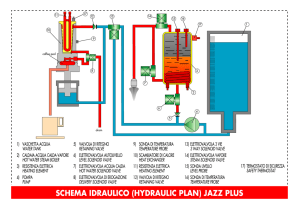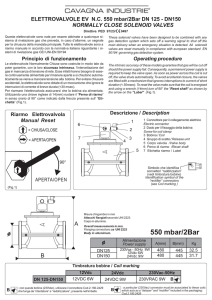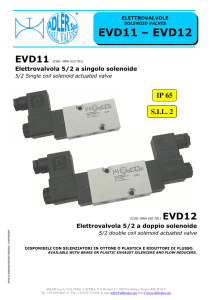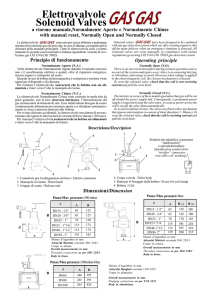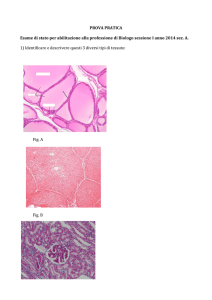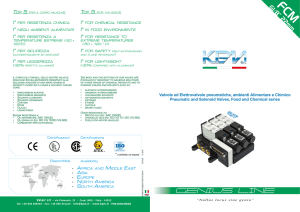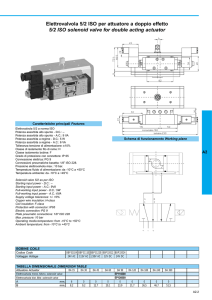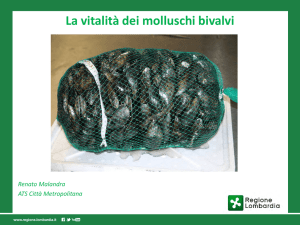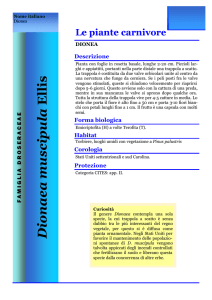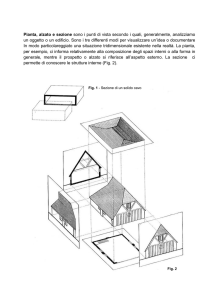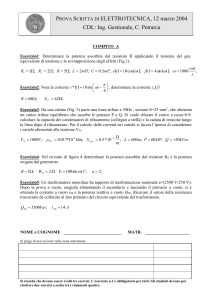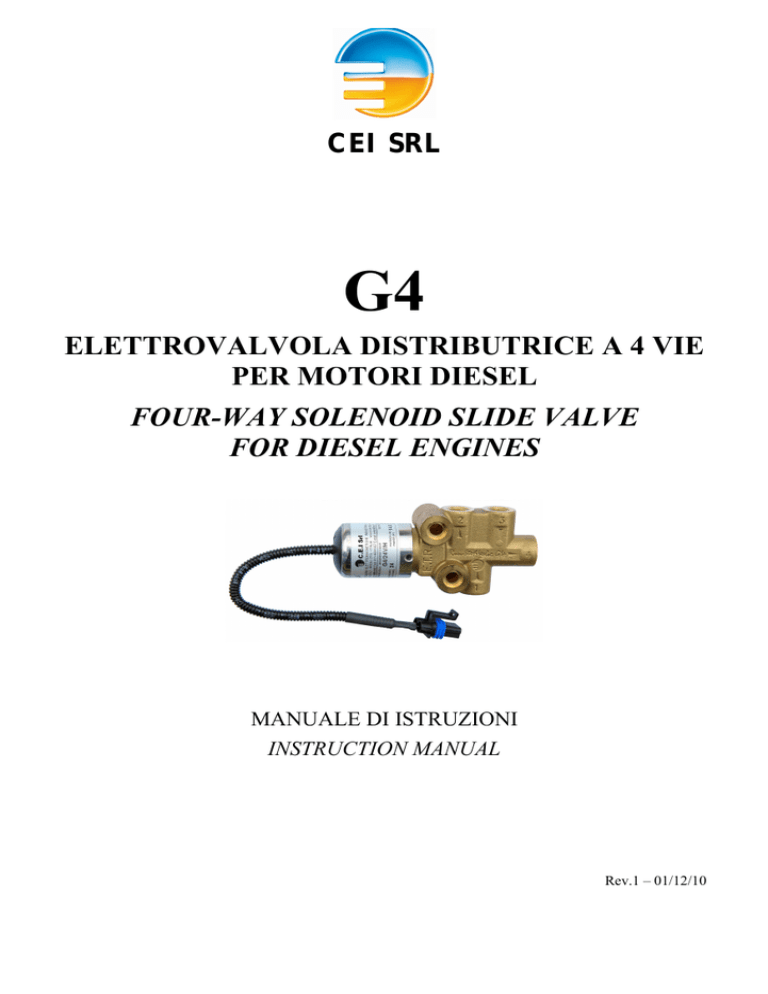
CEI SRL
G4
ELETTROVALVOLA DISTRIBUTRICE A 4 VIE
PER MOTORI DIESEL
FOUR-WAY SOLENOID SLIDE VALVE
FOR DIESEL ENGINES
MANUALE DI ISTRUZIONI
INSTRUCTION MANUAL
Rev.1 – 01/12/10
DICHIARAZIONE DI CONFORMITA’
La C.E.I. Srl dichiara che l’elettrovalvola G4 è conforme alle seguenti
normative:
2006/42/EC (Direttiva Europea Macchine)
2004/108/EC (Direttiva Compatibilità Elettromagnetica)
2006/95/EC (Direttiva Bassa Tensione)
e successive modifiche
L’elettrovalvola G4 è destinata ad essere incorporata per costruire una
macchina e non dev’essere messa in servizio prima che la macchina finale,
nella quale dovrà essere installata, non sia conforme alle disposizioni della
Direttiva Europea Macchine 2006/42/EC, quando applicabile.
COMPLIANCE DECLARATION
C.E.I. Srl declares the G4 solenoid valve is in compliance with the
rules contents in:
2006/42/EC (Machinery Directive)
2004/108/EC (Electromagnetic Compatibility Standard)
2006/95/EC (Low Voltage Standard)
The G4 solenoid valve is intended to be incorporated to constitute machinery
and must not be put into service until the final machinery, into which it is to be
incorporated, is according to the regulations of the EC Machinery Directive
2006/42/EC, if applicable.
Il Responsabile tecnico – The technical manager
C.E.I. Srl
Corso P. Levi, 7 - 10098 Rivoli (TO) ITALIA
Tel. 0039 011 9594446 - FAX 0039 011 9591357
E-mail: [email protected]
2
INGOMBRI MECCANICI
OVERALL DIMENSIONS
FIG.1
3
APPLICAZIONE IN FUNZIONE E.T.R. - ECCITAZIONE
USING THE E.T.R. MODE - ENERGIZATION
FIG.2
APPLICAZIONE IN FUNZIONE E.T.S. - DISECCITAZIONE
USING THE E.T.S. MODE - DE-ENERGIZATION
FIG.3
4
ITALIANO
INTRODUZIONE
Prima della messa in funzione dell’elettromagnete, leggere attentamente il
presente libretto di istruzioni al fine di prevenire incidenti ed assicurare un
perfetto funzionamento.
Le istruzioni devono essere tenute a portata di mano e devono essere cedute
all'utente successivo in caso di vendita del pezzo.
Nel libretto di istruzioni viene usata la seguente simbologia:
PERICOLO
Questo simbolo riguarda le procedure di lavoro e di funzionamento che devono
essere rispettate attentamente per evitare pericoli all'utente o ad altre persone.
ATTENZIONE
Questo simbolo riguarda le informazioni che devono essere rispettate per
evitare danni all'apparecchio.
NOTA
Questo simbolo indica informazioni aggiuntive o consigli utili per
l’installazione.
MISURE DI SICUREZZA
Tenere presente che questa guida è rivolta a personale qualificato, che dispone
di adeguata formazione, di attrezzature idonee e che è informato sull’ambiente
di lavoro in cui si trova ad operare. Senza la dovuta formazione sulle procedure
di lavoro e sull’uso delle attrezzature, queste ultime possono causare danni alla
persona e al prodotto.
Le indicazioni relative alla tensione di rete e al tipo di corrente riportati
nelle caratteristiche dell’elettromagnete devono corrispondere alle
caratteristiche del vostro impianto elettrico.
Utilizzate l’elettrovalvola G4 esclusivamente con gasolio per
autotrazione. Eventuali altri combustibili in alternativa devono essere
approvati dal costruttore.
L’elettrovalvola deve essere impiegata solamente per l'uso a cui è
destinato. Non utilizzare l’elettrovalvola in impianti oleodinamici o
idraulici.
5
Prima della messa in funzione, assicurarsi che il connettore di
alimentazione non sia danneggiato.
Non sollevare l’elettrovalvola prendendola dal cavo.
Scollegare l’elettrovalvola prima di effettuare interventi di
manutenzione o sostituzione. E’ vietato effettuare qualsiasi variazione o
modifica senza autorizzazione.
Non montare il pezzo in ambienti con temperatura superiore a 100°C e
in presenza di fiamme libere.
DESCRIZIONE DELL’ELETTROVALVOLA (FIG.1)
La G4 è un’elettrovalvola distributrice a 4 VIE per l'arresto e l'avvio rapido dei
motori, per funzioni in DISECCITAZIONE (Energized to Run - E.T.R.) e in
ECCITAZIONE (Energized to Stop - E.T.S.).
Nella fase di fermata del motore utilizza la depressione in aspirazione della
pompa di alimentazione per aspirare combustibile dalla pompa di iniezione.
Le parti fondamentali dell’elettrovalvola sono:
1. Corpo dell’elettromagnete
2. Cassetto distributore in ottone
3. Cavi di alimentazione inguainati
4. Connettore elettrico
Il connettore elettrico standard è il Packard stagno tipo 280 METRIPACK. Il connettore portafemmina è aggraffato sui cavi, mentre il
portamaschio è fornito in kit.
Su richiesta è possibile fornire in alternativa il connettore Tyco
Superseal 1.5.
UTILIZZO DELL’ELETTROVALVOLA (FIG.2 E FIG.3)
L'applicazione sui motori é semplice perché il duplice sistema di fermata
E.T.R. ed E.T.S. si ottiene ribaltando la stessa elettrovalvola e collegando i tubi
secondo le frecce stampate sul cassetto in ottone.
FIG.4
6
AVVIAMENTO DEL MOTORE IN ECCITAZIONE (Energized to Run - E.T.R.)
– FIG.2
Il motore va in moto con la G4 eccitata. Diseccitando la elettrovalvola avviene
il rapido arresto del motore e i condotti rimangono pieni di combustibile per il
successivo avvio.
AVVIAMENTO DEL MOTORE IN DISECCITAZIONE (Energized to Stop E.T.S.) – FIG.3
Il motore va in moto con la G4 diseccitata. Eccitando la elettrovalvola avviene
il rapido arresto del motore e i condotti rimangono pieni di combustibile per il
successivo avvio.
Utilizzare l’elettrovalvola
autotrazione.
esclusivamente
con
gasolio
per
MONTAGGIO DELL’ELETTROVALVOLA
•
L'elettrovalvola deve essere installata su una superficie rigida e piana il più
vicino possibile alla pompa di iniezione. La distanza ottimale non dovrebbe
superare i 200 mm.
Se la superficie non è in piano si possono verificare deformazioni del
cassetto d’ottone con conseguente blocco del nucleo mobile interno.
Se la distanza è eccessiva, l’arresto del motore è meno rapido.
•
Usare le viti Unbrako con gambo rettificato in dotazione rispettando la
coppia di serraggio di 11-12 Nm.
L’uso di altre viti senza battuta sul filetto M6 può provocare
deformazioni del cassetto d’ottone, causa di malfunzionamento..
Se la coppia di serraggio è eccessiva, si può deformare il cassetto
d’ottone.
•
Per la connessione della elettrovalvola è preferibile l'uso di tubi flessibili.
Nel caso si dovessero utilizzare dei tubi
rigidi é indispensabile curare il loro perfetto
allineamento allo scopo di evitare distorsioni
del corpo in ottone della valvola (Fig.5)
FIG.5
7
•
Si raccomanda l'impiego di guarnizioni D.14.3x1.5 mm in acciaio o
alluminio con inserto in gomma (Cod. CEI 111088) per le loro
caratteristiche di ermeticità.
Nel chiudere i tubi rispettare i valori di coppia:
- 30-35 Nm per guarnizioni in acciaio o alluminio con inserto in gomma
- 35-40 Nm per guarnizioni in rame ricotto
•
Verificare che non sia rimasta dell'aria all'interno dei tubi al termine
dell'installazione della G4.
Eventuale aria all’interno del condotto condiziona l’aspirazione di
carburante da parte della pompa di alimentazione
•
Si raccomanda la presenza del filtro sulla mandata per eliminare eventuali
impurità nel gasolio
Eventuali impurità nel gasolio possono bloccare il nucleo mobile della
valvola
•
Verificare la presenza della valvola di ritegno sul tubo di ritorno al
serbatoio.
Disponibile kit raccordi per tubi in gomma da 3/8” descritto in Fig.7
(Cod. CEI 111105)
COLLEGAMENTO ELETTRICO
Con la versione standard sono forniti un connettore portamaschi tipo Packard,
nr.2 gommini e nr.2 terminali maschi da montare sul cavo di alimentazione
dell’impianto.
• Spellare 4 mm di guaina e aggraffare il
terminale maschio A e il gommino B sui due
cavi di alimentazione (fig.6)
FIG.6
Verificare il corretto montaggio dei terminali sul filo di rame, tirando a
mano il filo aggraffato per controllarne la tenuta. Controllare che le
linguette C del terminale siano schiacciate sul rame e non sulla guaina.
• Agganciare i terminali aggraffati sul connettore portamaschi. Non c’è
polarità da rispettare.
• Inserire il connettore appena montato sul connettore portafemmina della
G4, verificando il corretto aggancio tra le controparti.
• Per non avere i cavi di alimentazione volanti fascettarli su una parte del
motore, evitando zone calde.
8
FIG.7
Kit raccordi per tubi in gomma 3/8”:
RDD raccordo dritto (3 pz)
RDC raccordo a occhio (1 pz)
BC bullone cavo (1 pz)
AC guarnizione di tenuta (5 pz)
SPECIFICHE TECNICHE
Tensione di alimentazione:
Potenza nominale a 20°C:
Servizio:
Temperatura di funzionamento:
Portata:
Pressione massima di lavoro:
Posizione di montaggio:
Peso:
Rivestimento:
Protezione:
Classe isolamento:
Test vibrazioni:
Livello di vibrazioni:
Livello di pressione acustica:
G4/12V
11-14.4 VCC
G4/24V
22-28.8 VCC
14W a 12V
14.5W a 24V
ED100%
-40°C ; 100°C
3.6 l/min a 1.5 bar
4.5 bar sulla pompa iniezione
orizzontale o verticale
1 Kg
Zincatura a norma Rohs
IP55
H (180°C)
20 G 50-500 Hz su 3 assi
assente
assente sotto tensione
9
RISOLUZIONE DEI PROBLEMI
La tabella che segue è un check-list per individuare i problemi più comuni. In
caso di mancata risoluzione del problema o per sostituire una G4 contattare la
CEI.
Un singolo evento di guasto può capitare, ma quando si ripete sostituendo
il pezzo, sicuramente c’è un problema sull’applicazione: modello non
indicato o errore sistematico di montaggio.
Problema
riscontrato
Possibile causa
L’elettrovalvola Non arriva corrente
non scatta
La tensione è troppo
bassa
L’elettrovalvola è
bloccata causa
deformazione del
cassetto
L’elettrovalvola è
bloccata causa
impurità nel gasolio
La pressione
dell’impianto è
eccessiva
L’elettrovalvola Mancanza di valvola
di ritegno sul ritorno
scatta, ma il
al serbatoio
motore non si
arresta
Presenza di aria
nell’impianto
La valvola è troppo
lontana dalla pompa
iniezione
Possibile soluzione
Verificare il connettore di alimentazione
(corretta aggraffatura dei fili)
Verificare che la batteria fornisca la tensione
nominale con una tolleranza del 10%
Verificare le coppie di serraggio dei tubi e del
cassetto (su superficie piana)
Verificare l’allineamento dei tubi, se sono
rigidi
Smontare e pulire la valvola per es. soffiando
con aria compressa.
Aggiungere un filtro supplementare sulla
mandata
Verificare che la pressione non superi quanto
dichiarato nelle caratteristiche della G4
Aggiungere la valvola di non ritorno
Eliminare l’aria
Verificare le guarnizioni
Avvicinare la G4 al motore
A motore caldo il solenoide della valvola dispone di meno forza per
scattare. E’ importante quindi avere la batteria in ordine.
10
ISTRUZIONI PER LO SMALTIMENTO DEL PRODOTTO
Trattasi di AEE (apparecchio elettrico o elettronico), che nel caso di
smaltimento dovrà essere dovrà essere depositato negli appositi
contenitori RAEE (rifiuti di apparecchiature elettriche ed elettroniche)
al fine di essere inviato ad una riutilizzazione ecologica (Direttiva CE
2002/96). Non disperdere nell’ambiente, non gettare il prodotto
dismesso tra i rifiuti domestici.
CONDIZIONI DI GARANZIA
La CEI garantisce la buona qualità e la buona costruzione dei materiali venduti
obbligandosi, durante il periodo di garanzia di un anno dalla data di vendita
(due anni per l’utilizzatore finale che non svolge attività professionale), a
sostituire gratuitamente nel più breve tempo possibile quelle parti che venissero
riconosciute come difettose nelle normali condizioni di lavoro, sempre che ciò
non dipenda da naturale logoramento, da guasti causati da imperizia o uso
improprio, da interventi non autorizzati, da manomissioni eseguite o fatte
eseguire dall'utilizzatore, dal caso fortuito e da condizioni di impiego non
previste a progetto o nel libretto di istruzioni.
I lavori inerenti alle riparazioni e alle sostituzioni in garanzia saranno eseguiti
presso la CEI e nulla sarà dovuto all'acquirente per eventuali spese di
manutenzione sostenute presso l’utilizzatore e per il tempo durante il quale
l'impianto o l’apparecchiatura rimarranno inoperosi.
Questa garanzia incorpora e sostituisce ogni altra garanzia legale sui difetti.
11
ENGLISH
INTRODUCTION
Please read the operating instructions carefully before using the solenoid valve
to prevent accidents and ensure the trouble-free operation.
Make sure you keep the instructions at hand for quick reference. If you resell
the solenoid or give it to another user, please include these instructions.
The following symbols are used in the instructions:
DANGER
This symbol draws your attention to work processes or operating procedures
that have to be carefully observed in order to prevent serious injury to the user
or another person.
CAUTION
This symbol draws your attention to information you need to ensure that your
solenoid is not damaged due to improper or careless use.
PLEASE NOTE
This symbol shows additional information or useful suggestions for the
installation.
SAFETY MEASURES
Always remember that this guidebook is addressed to skilled personnel, having
received appropriate education and training, supplied with suitable equipment
and acquainted with the features of the working environment where they are
operating. Knowledge of working procedures and use of equipment is essential
to prevent from injury or damages possibly arising from the same equipment.
The main voltage and current type specified on the G4 documentation
must match the features of your electric system.
Use the G4 solenoid valve with diesel fuel. Other fuels in alternative
must be approved by the manufacturer.
The G4 solenoid valve must only be employed for its intended use.
Do not use the solenoid valve in hydraulic and oil-pressure installations.
12
Before the operation, make sure that the connector is not damage.
Do not lift the solenoid valve by the cable.
Disconnect the electromagnet before starting any servicing activity or
replacement. Carrying out any change or modification without prior
authorization is prohibited.
Do not assemble the part with ambient temperature higher than 100°C
or in presence of open flames.
DESCRIPTION (FIG.1)
This is a four-way solenoid slide valve for fast engine ignition and shutdown,
having both an E.T.R. (Energized To Run) mode and an E.T.S. (Energized To
Stop) mode operation.
During engine shutdown, the suction from the fuel supply pump is used to
withdraw fuel from the injection pump.
The important parts of the solenoid valve are:
1. Solenoid
2. Brass body valve
3. Protected cables
4. Electrical connector
The standard electrical connector is the sealed Packard type 280
METRI-PACK. The receptacle housing is crimped on the cables, while
the tab housing is loose in the bag.
On demand we can supply as alternative the Tyco Superseal 1.5
connector.
USE (FIG.2 AND FIG.3)
The application on engines is simple because the dual stopping system, E.T.R.
and E.T.S., is obtained by inverting the solenoid valve itself and connecting the
pipes according to the arrows on the brass housing.
FIG.4
13
ENERGIZED TO RUN (E.T.R. mode) – FIG.2
The engine ignites when the valve is energized. De-energizing the valve
quickly brings the engine to a stop, leaving the pipes filled with fuel in
preparation to the next ignition..
ENERGIZED TO STOP (E.T.S. mode) – FIG.3
The engine ignites when the valve is de-energized. Energizing the valve
quickly brings the engine to a stop, leaving the pipes filled with fuel in
preparation to the next ignition.
Use the G4 solenoid valve only with diesel fuel.
INSTALLATION
•
The solenoid valve must be installed on a rigid and flat surface as close as
possible to the injection pump. The optimal distance should not exceed 200
mm.
If the surface is not plain, some deformations of the brass body with
consequent block of the internal plunger could happen.
If the distance is excessive, the stop of the engine is slower.
•
Use the Unbrako screws in kit, observing the torque values 11-12 Nm.
The use of other screws without limitation of the M6 thread could cause
deformations of the brass body and malfunction.
•
If the torque is excessive, some distortions of the brass body could
happen.
For connection of the solenoid valve, you are recommended to use hoses.
Should it be necessary to use rigid pipes, it
is absolutely essential to make sure that they
are perfectly aligned in order to prevent any
distortion of the body of the valve that might
hinder proper operation of the solenoid valve
(Fig.5).
FIG.5
14
•
Make sure to use sealing washers size 14.3x1.5 mm (steel or aluminium
with rubber inserts, P/N CEI 111088) on account of their characteristics of
tightness.
Make sure to apply the corresponding torque values:
- 30-35 Nm for steel or aluminium washers with rubber inserts
- 35-40 Nm for annealed copper washers
•
After the installation of the G4 make sure that there is not air inside the
pipes.
Incidental air inside the pipes conditions the aspiration of fuel by the
feeding pump.
•
A filter to eliminate every possible impurity in the fuel is recommended.
Incidental impurity in the fuel could stop the plunger of the valve
•
Verify the presence of the check valve on the return pipe to the tank
Available 3/8” rubber pipe fittings kit (P/N CEI 111105), as you can see
in fig.7
ELECTRICAL CONNECTION
In the standard version a tab Packard housing, no.2 single wire seals and no.2
tab contacts are supplied to be assembled on the feeding cable of the electrical
system.
• Strip 4 mm of sheath and crimp the tab
contact A and the wire seal B on the two
feeding cables (fig.6)
FIG.6
Check the correct assembly of the tab contacts on the copper wire
pulling the cable by hand to verify the resistance. Check whether the
metal strip C of the contact is crimped on the copper, not on the sheath.
•
Join the crimped contacts to the tab housing. No polarity to respect.
•
Join together the tab housing and the receptacle housing of the G4 valve,
checking the correct hooking between the parts.
•
To avoid movable electrical cables block them by ties on a cold part of the
engine.
15
FIG.7
3/8” rubber pipe fittings kit:
Straight fitting RDD (3 items)
Eye fitting (1 item)
Hollow bolt BC (1 item)
Self-centring bonded seal AC (5 items)
TECHNICAL DATA
Voltage supply:
Rated power @ 20°C:
ED:
Ambient temperature:
Flow rate:
Fitting position:
Max working pressure :
Weigth :
Treatment :
Protection type:
Insulation class:
Vibration test
Vibration level:
Noise level:
G4/12V
11-14.4 VDC
G4/24V
22-28.8 VDC
14W a 12V
14.5W a 24V
100%
-40° to 100°C
3.6 l/min @ 1.5 bar
vertical or horizontal
4.5 bar on injection pump
1 Kg
zinc-plating Rohs conform
IP55
H (180°C)
20 G 50-500 Hz on three axes
none
none
16
SOLUTION OF TROUBLES
The following table is a check-list useful to identify the most common troubles.
Should it not be possible to solve problems or to replace a G4, please contact
CEI.
A single failing event may occur, however when it recurs after the part
has been replaced, it is certain that a problem exists on the application, as
e.g. unsuitable part model or systematic assembly error.
Detected trouble Possible cause
The solenoid
valve does not
work
The solenoid
valve works, but
the engine does
not stop
Possible solution
No current
Check the feeding connector (tab contact well
crimped on the cables )
Too low voltage
Check that the battery provide the rated
voltage with 10% tolerance.
Check the torque values of screws of the brass
body (on plain surface) and of the pipes. For
the rigid pipes check whether they are
perfectly aligned.
Disassemble and clean the valve blowing by
compressed air
Add an additional filter on the feeding pipe.
Compare working pressure with the technical
data of the G4
Add the check valve
The valve does not
work for
deformation of the
brass body
The valve does not
work for impurities
in the fuel
Too high working
pressure
No check valve on
the return pipe to
the tank
Air in the feeding
system
Excessive distance
of the valve from
the injection pump
Eliminate the air
Check the gaskets
Bring the G4 solenoid valve near to the engine
The force of the solenoid decreases increasing the temperature of the
engine. So it’s important to have the battery in order.
17
INSTRUCTIONS FOR DISPOSAL
This article is classified as EEE (electrical and electronic equipment)
and must therefore be disposed of in the appropriate recycling
receptacles of WEEE (waste electrical and electronic equipment) and
sent for recovery in an environmentally friendly manner (European
Directive 2002/96EC). Do not dispose of electrical and electronic
equipment in the environment or in household waste.
WARRANTY CONDITIONS
CEI guarantees good quality and good conditions of materials sold, with the
obligation, during the warranty period of one year from the date of sale to
replace free of charge in the shortest time possible any parts acknowledged as
faulty under normal working conditions, providing this is not caused by natural
wear, failures caused by incompetency or improper use, by unauthorised
interventions, by tampering carried out or authorised by the user, by fortuitous
events and/or conditions of use not foreseen by the design or in the instructions
handbook.
Work regarding repairs and replacement of parts under warranty shall be
carried out in the works of CEI and there shall be nothing due to the purchaser
for any maintenance costs sustained by the user and for the time in which the
system or equipment shall remain inoperative.
This warranty incorporates ands replaces any other legal guarantee concerning
defects.
18
C.E.I. SRL
COSTRUZIONI ELETTROMAGNETICHE INDUSTRIALI
Corso P. Levi, 7 - 10098 – Rivoli (TO) - ITALY
Tel.: 0039 011 9594446 - FAX 0039 011 9591357
www.cei–italy.it
e-mail: [email protected]
[email protected]
19

